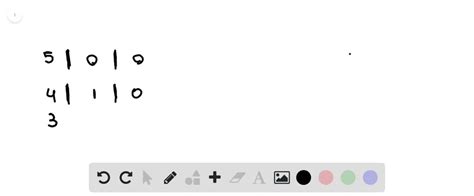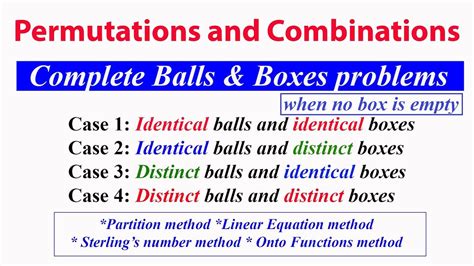list all forms of distributing balls into boxes r In this section, we want to consider the problem of how to count the number of ways of distributing k balls into n boxes, under various conditions. The conditions that are generally imposed are . Fire an electric web at the junction box and the door opens. Officer Davis finds a hidden panel in one of the shipping crates. Hit R3 to follow the lines to the junction box on the upper floor.
0 · math 210 distribution balls
1 · how to distribute objects in r
2 · how to distribute n boxes
3 · how to distribute k into boxes
4 · how to distribute k balls into boxes
5 · distribution of balls into boxes pdf
6 · distributing balls to boxes
7 · distribute n identical objects in r
• Housed in a junction box for ease of mounting, along with wiring and connection protection • Software is configurable via USB port • All 8 outputs are internally protected and fused
Given an array arr[] of size N, representing the number of balls of each of N distinct colors, the task is to find the probability of distributing all the balls into two boxes, such that both the boxes contain an equal number of distinct colored balls. Examples: Input: arr[] = {1, .In this section, we want to consider the problem of how to count the number of ways of distributing k balls into n boxes, under various conditions. The conditions that are generally imposed are . Distribute $a + b + c$ distinct balls into boxes $A, B, C$ such that $a$ balls, $b$ balls and $c$ balls go to boxes $A, B, C$
function alloc(balls, boxes): if boxes = 1 return [balls] else for n in range 0:balls return alloc(balls-n, boxes-1) That's the basic recursion logic: pick each possible quantity of balls, then recur on .
General formula to find number of ways of distributing n identical balls in r identical boxes such that no box is empty (Partition method). Link to partition function video: • Partition. In the case of distribution problems, another popular model for distributions is to think of putting balls in boxes rather than distributing objects to recipients. Passing out . Distribution of n (Different,Identical) Balls into r (Different,Identical) Boxes or Groups #INPSPart#1 Permutation & Combination https://youtu.be/A0e32NE7b8.
It's surprisingly simple. By choosing a max difference between the allocated balls, you are practically reducing the number of balls that can change their position. Set c to 0 and . First, we pick which k of the n boxes we want to use at all. That's nCk. This chooses which boxes contain one object and which contain none. Then we count in how many .Question: Randomly distribute r balls in n boxes. Find the probability that the first box is empty. I think I should make the question into 3 cases, namely, r=n, rn. CASE r=n: (r 2) (r 2) .Tour Start here for a quick overview of the site Help Center Detailed answers to any questions you might have Meta Discuss the workings and policies of this site
Distributing objects into boxes . Discrete Math We have 8 identical red balls, 15 identical blue balls and 4 numbered (distinguishable) boxes. If there are balls in a box the number of blue balls has to be greater than red balls or there musn't be any balls in a .
math 210 distribution balls

In other words, distributing k distinguishable balls into n distinguishable boxes, with exclusion, is the same as forming a permutation of size k, taken from the set of n boxes $$\prod_{i=0}^{r-1} (s-i)$$ 4- we can think .Suppose n [; \geq ;] 1, and you are given 2n distinguishable balls and n distinguishable boxes. The balls are to be put in the boxes at random, and assume that all possible ways of doing so are equally likely. (a) Find the probability that at least one box contains three or more balls.
how many types of cnc machines
I know that for distributing n balls in k boxes, the formula is ${n+k-1}\choose{n}$ But this is for indistinguishable balls. . $\begingroup$ This amounts to picking boxes for the balls to go into, where order matters. So you are just doing permutations with repetitions on the boxes. $\endgroup$ – Arturo Magidin. assuming that we distributed n distinct balls into n distinct boxes what is the probability that we have only one empty box $$$$ my approach: We can choose the empty box in n different ways we can choose the box that contains two balls in n-1 ways and we can distribute n-1 balls into n-1 box in (n-1)! which leaves us with: $$\frac{(n-1)!(n-1 . So we choose 1 from our n balls and put it into a box: ${n \choose 1}$. Now we have a box with a ball and a box without a ball, which makes the boxes distinguishable and n-1 balls remaining to be distributed into those boxes. . Distinguishable balls in two types of indistinguishable boxes. 2. Counting problem: multiple scenarios for .
All the 7 balls are to be distributed among the 5 boxes placed in a row so that any box can receive any number of balls. Suppose all the balls and all the boxes are identical. Then, in how many ways can all these all be distributed among these boxes so that no box remains empty and no two boxes have the same number of balls? Tour Start here for a quick overview of the site Help Center Detailed answers to any questions you might have Meta Discuss the workings and policies of this site The go-to approach for distributing n distinct objects into r alike boxes is S(n,r). (Stirling no. of the second kind). . the exponential generating function form for each boxes is equal to $$\bigg(\frac{x^2}{2!}+ \frac{x^3}{3!} + \frac{x^4}{4!} + . Distinct balls into distinct boxes with a minimal number of balls in each box. 2.
how to distribute objects in r
$\begingroup$ Your answer is correct, assuming that each box is required to get at least one ball, and your reasoning is correct as well. By the way, this is equal to $$\sum_{k=0}^r(-1)^{r-k}\binom{r}kk^n\;,$$ by an inclusion-exclusion . Tour Start here for a quick overview of the site Help Center Detailed answers to any questions you might have Meta Discuss the workings and policies of this site
600 identical balls must be randomly distributed into 6 numbered boxes. What is the probability of exactly 300 balls ending up in the first three boxes? Note that all balls must be distributed but boxes can be empty. I think I have solved it but I don't know if it is right since the way I solved it looks wrong, but let me explain how I did it.VIDEO ANSWER: Find a generating function for a_r- the number of ways of distributing r similar balls into 7 numbered boxes where the second, third, fourth, and fifth boxes are nonempty. For Educators Login
Here,the the black and white boxes are identical,and it matters how we put the black squares into the white boxes.So,I tried doing ordered partitions.But,my answer doesn't match that way. First of all I did 4C2,choosing 2 rows out of 4
If so, you place k balls in one box, and move on - with n-k balls left, and set the box you just filled aside. Otherwise, you advance k by one, because there is no box with fewer balls than k (problem requirement), and also we now know there is no box with exactly k balls, so you can be assure all boxes have k+1 balls or more. – $\color{black}{\text{BIG HINT:}}$ Your main mistake is to approach probability question like it is a combinatorics questions. Do not forget that if we work over probability , it does not matter whether balls or bins are distinguishable or not , you must see them as distinguishable.

Correct option (c) Explanation: The total number of ways of distributing n balls into m boxes is mn which are assumed to be equally likely. Since r balls which should go to the specified box can be chosen in n C r ways and for any such way the remaining (n – r) balls can be distributed to the [where A is the event that a specified box will contain r balls] If all three balls are in the same box, there are $ such ways. If two balls are in one box, and one in another, there are \cdot 3 = 12$ ways. If there is one ball per box, there are $ such ways (determined by the sole empty box). + 12 + 4 = 20$
Given an array arr[] of size N, representing the number of balls of each of N distinct colors, the task is to find the probability of distributing all the balls into two boxes, such that both the boxes contain an equal number of distinct colored balls. Examples: Input: arr[] = {1, 1}, N = 2Output: 1.00000Explanation: Two possible ways to distribute
how to distribute n boxes

Tour Start here for a quick overview of the site Help Center Detailed answers to any questions you might have Meta Discuss the workings and policies of this site We are required to find he number of ways of distributing the balls into the boxes such that each box has even number of balls. We consider each ball to be distinct. Similarly, each box is distinct.

Combinatorics - Distributing n balls to 2 boxes. 2. . How many ways to put indistinguishable balls into distinguishable boxes with restrictions? 0. Distributing $ indistinguishable black marbles and $ distinguishable .Tour Start here for a quick overview of the site Help Center Detailed answers to any questions you might have Meta Discuss the workings and policies of this site
I have this question: Find in how many ways we can distribute $ similar balls to $ different boxes such that in no box there are exactly $ balls.; Find in how many ways we can distribute $ different balls to $ different boxes such that no box has exactly $ balls; For the first part, I did the inclusion-exclusion principle.
$\begingroup$ So if you have, say, 3 balls and 4 boxes, and you put the first ball into any box, the second ball into any box, and the third ball into any box. Then when you are done each box will contain any number of the balls: from none, one, two, to all three., depending on how you placed them. $\endgroup$ – Graham Kemp Your solution is not quite correct because you are counting some possibilities where two of the boxes are empty. Your denominator is indeed ^5 = 243$.If Box $ is to be empty, then there are ^5=32$ ways to distribute the $ balls among the other two boxes. But two of those combinations (all balls in Box $ and all balls in Box $) are forbidden, so there .
how many cubic inches in 4 x4 square electrical box
how many wires can go into one junction box
How was sheet metal made in ancient times? Sheet metal making dates back to the times of ancient Egypt, where they crafted metal into various shapes. The process involved hammering metal into sheets, after which they would be .
list all forms of distributing balls into boxes r|distribute n identical objects in r